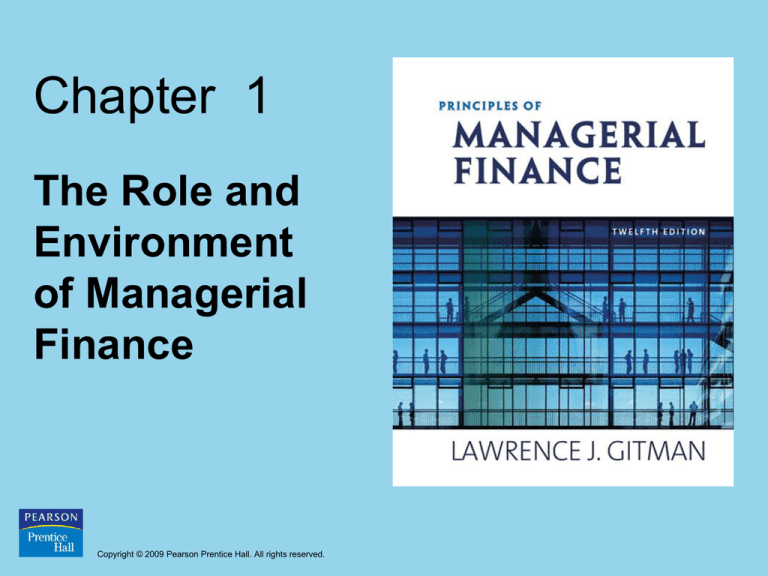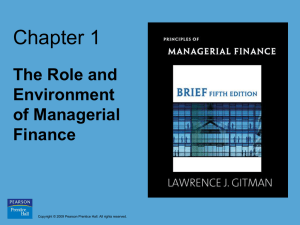
Chapter 1
The Role and
Environment
of Managerial
Finance
Copyright © 2009 Pearson Prentice Hall. All rights reserved.
Learning Goals
1. Define finance, its major areas and opportunities
available in this field, and the legal forms of business
organization.
2. Describe the managerial finance function and its
relationship to economics and accounting.
3. Identify the primary activities of the financial
manager.
4. Explain the goal of the firm, corporate governance,
the role of ethics, and the agency issue.
Copyright © 2009 Pearson Prentice Hall. All rights reserved.
1-2
Major Areas & Opportunities in Finance:
Managerial Finance
• Managerial finance is concerned with the duties of the
financial manager in the business firm.
• The financial manager actively manages the financial
affairs of any type of business, whether private or
public, large or small, profit-seeking or not-for-profit.
• They are also more involved in developing corporate
strategy and improving the firm’s competitive position.
Copyright © 2009 Pearson Prentice Hall. All rights reserved.
1-3
Major Areas & Opportunities in Finance:
Managerial Finance (cont.)
• Increasing globalization has complicated the
financial management function by requiring
them to be proficient in managing cash flows in
different currencies and protecting against the
risks inherent in international transactions.
• Changing economic and regulatory conditions
also complicate the financial management
function.
Copyright © 2009 Pearson Prentice Hall. All rights reserved.
1-4
Table 1.1 Strengths and Weaknesses of the
Common Legal Forms of Business Organization
Copyright © 2009 Pearson Prentice Hall. All rights reserved.
1-5
Figure 1.1 Corporate Organization
Copyright © 2009 Pearson Prentice Hall. All rights reserved.
1-6
The Managerial Finance Function
• The size and importance of the managerial finance
function depends on the size of the firm.
• In small companies, the finance function may be
performed by the company president or accounting
department.
• As the business expands, finance typically evolves into
a separate department linked to the president as was
previously described in Figure 1.1.
Copyright © 2009 Pearson Prentice Hall. All rights reserved.
1-7
The Managerial Finance Function:
Relationship to Accounting
• The firm’s finance (treasurer) and accounting
(controller) functions are closely-related and
overlapping.
• In smaller firms, the financial manager generally
performs both functions.
Copyright © 2009 Pearson Prentice Hall. All rights reserved.
1-8
The Managerial Finance Function:
Relationship to Accounting (cont.)
• One major difference in perspective and
emphasis between finance and accounting is that
accountants generally use the accrual method
while in finance, the focus is on cash flows.
• The significance of this difference can be
illustrated using the following simple example.
Copyright © 2009 Pearson Prentice Hall. All rights reserved.
1-9
The Managerial Finance Function:
Relationship to Accounting (cont.)
• The Nassau Corporation experienced the following
activity last year:
Sales
$100,000 (1 yacht sold, 100% still uncollected)
Costs
$ 80,000 (all paid in full under supplier terms)
• Now contrast the differences in performance under the
accounting method versus the cash method.
Copyright © 2009 Pearson Prentice Hall. All rights reserved.
1-10
The Managerial Finance Function:
Relationship to Accounting (cont.)
INCOME STATEMENT SUMMARY
ACCRUAL
Sales
$100,000
Less: Costs
Net Profit/(Loss)
CASH
$
0
(80,000)
(80,000)
$ 20,000
$(80,000)
Copyright © 2009 Pearson Prentice Hall. All rights reserved.
1-11
The Managerial Finance Function:
Relationship to Accounting (cont.)
• Finance and accounting also differ with respect to
decision-making.
• While accounting is primarily concerned with the
presentation of financial data, the financial manager is
primarily concerned with analyzing and interpreting
this information for decision-making purposes.
• The financial manager uses this data as a vital tool for
making decisions about the financial aspects of the
firm.
Copyright © 2009 Pearson Prentice Hall. All rights reserved.
1-12
Figure 1.2 Financial Activities
Copyright © 2009 Pearson Prentice Hall. All rights reserved.
1-13
Goal of the Firm: Maximize Profit???
Which Investment is Preferred?
Earnings per share (EPS)
Investment
Year 1
Year 2
Year 3
Total (years 1-3)
Rotor
$
1.40 $
1.00 $
0.40 $
2.80
Valve
$
0.60 $
1.00 $
1.40 $
3.00
• Profit maximization fails to account for differences in the level
of cash flows (as opposed to profits), the timing of these cash
flows, and the risk of these cash flows.
Copyright © 2009 Pearson Prentice Hall. All rights reserved.
1-14
Goal of the Firm:
Maximize Shareholder Wealth!!!
• Why?
• Because maximizing shareholder wealth properly considers cash
flows, the timing of these cash flows, and the risk of these cash
flows.
• This can be illustrated using the following simple stock valuation
equation:
level & timing
of cash flows
Share Price = Future Dividends
Required Return
Copyright © 2009 Pearson Prentice Hall. All rights reserved.
risk of cash
flows
1-15
Goal of the Firm:
Maximize Shareholder Wealth!!! (cont.)
• The process of shareholder wealth maximization
can be described using the following flow chart:
Figure 1.3 Share Price Maximization
Copyright © 2009 Pearson Prentice Hall. All rights reserved.
1-16
Goal of the Firm:
What About Other Stakeholders?
• Stakeholders include all groups of individuals who
have a direct economic link to the firm including
employees, customers, suppliers, creditors, owners, and
others who have a direct economic link to the firm.
• The "Stakeholder View" prescribes that the firm make a
conscious effort to avoid actions that could be
detrimental to the wealth position of its stakeholders.
• Such a view is considered to be "socially responsible."
Copyright © 2009 Pearson Prentice Hall. All rights reserved.
1-17
Corporate Governance
• Corporate Governance is the system used to direct and
control a corporation.
• It defines the rights and responsibilities of key
corporate participants such as shareholders, the board
of directors, officers and managers, and other
stakeholders.
• The structure of corporate governance was previously
described in Figure 1.1.
Copyright © 2009 Pearson Prentice Hall. All rights reserved.
1-18
The Sarbanes-Oxley Act of 2002
• The Sarbanes-Oxley Act of 2002 (commonly called SOX)
eliminated many disclosure and conflict of interest problems that
surfaced during the early 2000s.
•
SOX:
–
–
–
–
–
established an oversight board to monitor the accounting industry;
tightened audit regulations and controls;
toughened penalties against executives who commit corporate fraud;
strengthened accounting disclosure requirements;
established corporate board structure guidelines.
Copyright © 2009 Pearson Prentice Hall. All rights reserved.
1-19
The Role of Ethics: Ethics Defined
• Ethics is the standards of conduct or moral
judgment—have become an overriding issue in
both our society and the financial community
• Ethical violations attract widespread publicity
• Negative publicity often leads to negative
impacts on a firm
Copyright © 2009 Pearson Prentice Hall. All rights reserved.
1-20
The Agency Issue:
The Agency Problem
• Whenever a manager owns less than 100% of the firm’s equity, a
potential agency problem exists.
• In theory, managers would agree with shareholder wealth
maximization.
• However, managers are also concerned with their personal
wealth, job security, fringe benefits, and lifestyle.
• This would cause managers to act in ways that do not always
benefit the firm shareholders.
Copyright © 2009 Pearson Prentice Hall. All rights reserved.
1-21
The Agency Issue:
Resolving the Problem
• Market Forces such as major shareholders and
the threat of a hostile takeover act to keep
managers in check.
• Agency Costs are the costs borne by
stockholders to maintain a corporate governance
structure that minimizes agency problems and
contributes to the maximization of shareholder
wealth.
Copyright © 2009 Pearson Prentice Hall. All rights reserved.
1-22
The Agency Issue:
Resolving the Problem (cont.)
• Examples would include bonding or monitoring
management behavior, and structuring
management compensation to make
shareholders interests their own.
• A stock option is an incentive allowing
managers to purchase stock at the market price
set at the time of the grant.
Copyright © 2009 Pearson Prentice Hall. All rights reserved.
1-23
The Agency Issue:
Resolving the Problem (cont.)
• Performance plans tie management
compensation to measures such as EPS growth;
performance shares and/or cash bonuses are
used as compensation under these plans.
• Recent studies have failed to find a strong
relationship between CEO compensation and
share price.
Copyright © 2009 Pearson Prentice Hall. All rights reserved.
1-24








